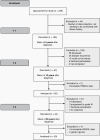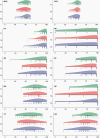Long-term wellbeing and neurocognitive functioning of diffuse low-grade glioma patients and their caregivers: A longitudinal study spanning two decades
- PMID: 35908832
- PMCID: PMC9925694
- DOI: 10.1093/neuonc/noac185
Long-term wellbeing and neurocognitive functioning of diffuse low-grade glioma patients and their caregivers: A longitudinal study spanning two decades
Abstract
Background: While patients with diffuse low-grade glioma (LGG) often survive for years, there is a risk of tumor progression which may impact patients' long-term health-related quality of life (HRQOL) and neurocognitive functioning (NCF). We present a follow-up of LGG patients and their informal caregivers (T3) who took part in our previous HRQOL investigations (T1, M = 7 and T2 M = 13 years after diagnosis).
Methods: Participants completed HRQOL (short form-36 health survey [SF-36]; EORTC-BN20), fatigue (Checklist Individual Strength [CIS]), and depression (Center for Epidemiological Studies-Depression [CES-D]) questionnaires and underwent NCF assessments. T3 scores were compared with matched controls. Changes over time (T1-T2-T3) on group and participant level were assessed. Where available, histology of the initial tumor was revised and immunohistochemical staining for IDH1 R132H mutant protein was performed.
Results: Thirty patients and nineteen caregivers participated. Of N = 11 with tissue available, 3 patients had confirmed diffuse LGG. At T3, patients (M = 26 years after diagnosis) had HRQOL and NCF similar to, or better than controls, yet 23.3% and 53.3% scored above the cut-off for depression (≥16 CES-D) and fatigue (≥35 CIS), respectively. Caregivers' HRQOL was similar to controls but reported high rates of fatigue (63.2%). Over time, patients' mental health improved (P < .05). Minimal detectable change in HRQOL over time was observed in individual patients (30% improvement; 23.3% decline; 20% both improvement and decline) with 23.3% remaining stable. NCF remained stable or improved in 82.8% of patients.
Conclusions: While HRQOL and NCF do not appear greatly impacted during long-term survivorship in LGG, depressive symptoms and fatigue are persistent.
Keywords: depression; fatigue; low-grade glioma; quality of life; survivorship.
© The Author(s) 2022. Published by Oxford University Press on behalf of the Society for Neuro-Oncology.
Figures



Similar articles
-
Health-related quality of life in stable, long-term survivors of low-grade glioma.J Clin Oncol. 2015 Mar 20;33(9):1023-9. doi: 10.1200/JCO.2014.56.9079. Epub 2015 Feb 9. J Clin Oncol. 2015. PMID: 25667287
-
Life after surgical resection of a low-grade glioma: A prospective cross-sectional study evaluating health-related quality of life.J Clin Neurosci. 2021 Jun;88:259-267. doi: 10.1016/j.jocn.2021.03.038. Epub 2021 Apr 22. J Clin Neurosci. 2021. PMID: 33992194
-
Internet-based guided self-help for glioma patients with depressive symptoms: a randomized controlled trial.J Neurooncol. 2018 Mar;137(1):191-203. doi: 10.1007/s11060-017-2712-5. Epub 2017 Dec 13. J Neurooncol. 2018. PMID: 29236238 Free PMC article. Clinical Trial.
-
Perioperative Neurocognitive Function in Glioma Surgery.Curr Oncol Rep. 2024 May;26(5):466-476. doi: 10.1007/s11912-024-01522-9. Epub 2024 Apr 4. Curr Oncol Rep. 2024. PMID: 38573439 Review.
-
Health-related quality of life aspects in patients with low-grade glioma.Adv Tech Stand Neurosurg. 2010;35:213-35. doi: 10.1007/978-3-211-99481-8_8. Adv Tech Stand Neurosurg. 2010. PMID: 20102116 Review.
Cited by
-
Symptom management in isocitrate dehydrogenase mutant glioma.Neurooncol Pract. 2024 Oct 19;12(Suppl 1):i38-i48. doi: 10.1093/nop/npae088. eCollection 2025 Feb. Neurooncol Pract. 2024. PMID: 39776527 Review.
-
The deleterious effect of WHO grade II diffuse glioma on socioeconomic status as evaluated through occupation.Sci Rep. 2025 Jul 2;15(1):23426. doi: 10.1038/s41598-025-08240-7. Sci Rep. 2025. PMID: 40603488 Free PMC article.
-
"It changes everything": Understanding how people experience the impact of living with a lower-grade glioma.Neurooncol Pract. 2024 Jan 29;11(3):255-265. doi: 10.1093/nop/npae006. eCollection 2024 Jun. Neurooncol Pract. 2024. PMID: 38737616 Free PMC article.
-
'A Constant Black Cloud': The Emotional Impact of Informal Caregiving for Someone With a Lower-Grade Glioma.Qual Health Res. 2024 Feb;34(3):227-238. doi: 10.1177/10497323231204740. Epub 2023 Nov 15. Qual Health Res. 2024. PMID: 37967320 Free PMC article.
-
Long-term neurocognitive function and quality of life after multimodal therapy in adult glioma patients: a prospective long-term follow-up.J Neurooncol. 2023 Sep;164(2):353-366. doi: 10.1007/s11060-023-04419-y. Epub 2023 Aug 30. J Neurooncol. 2023. PMID: 37648934 Free PMC article.
References
-
- Louis DN, Perry A, Reifenberger G, et al. . The 2016 World Health Organization classification of tumors of the central nervous system: a summary. Acta Neuropathol. 2016;131(6):803–820. - PubMed
-
- Olson JD, Riedel E, DeAngelis LM. Long-term outcome of low-grade oligodendroglioma and mixed glioma. Neurology. 2000;54(7):1442–1448. - PubMed
-
- Pignatti F, van den Bent M, Curran D, et al. . Prognostic factors for survival in adult patients with cerebral low-grade glioma. J Clin Oncol. 2002;20(8):2076–2084. - PubMed
-
- Reijneveld J, Sitskoorn M, Klein M, Nuyen J, Taphoorn M. Cognitive status and quality of life in patients with suspected versus proven low-grade gliomas. Neurology. 2001;56(5):618–623. - PubMed
MeSH terms
LinkOut - more resources
Full Text Sources
Medical
Miscellaneous

